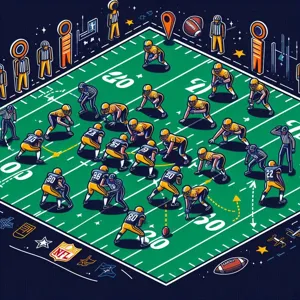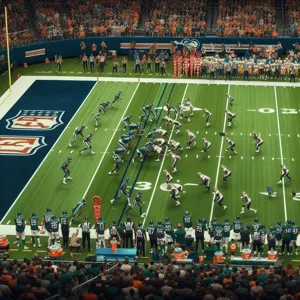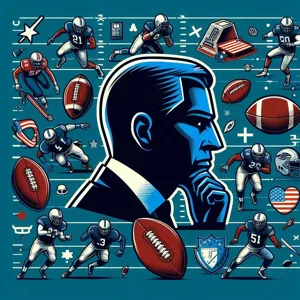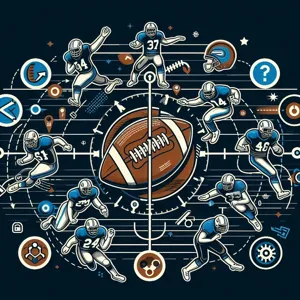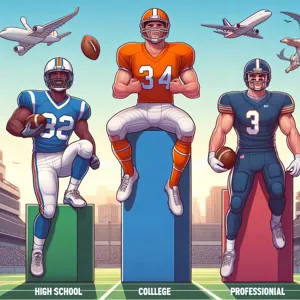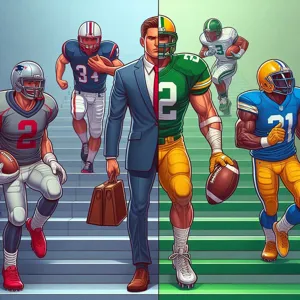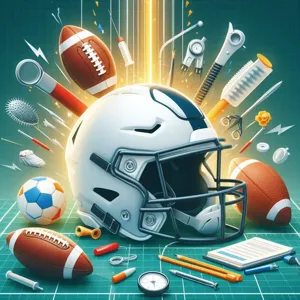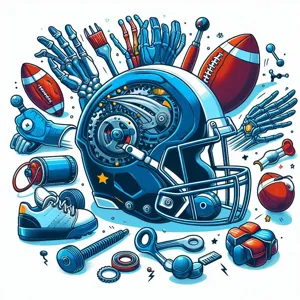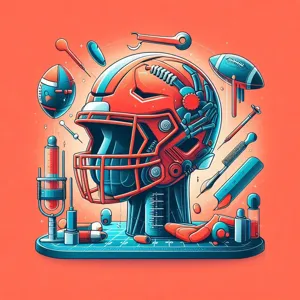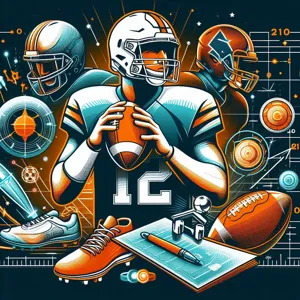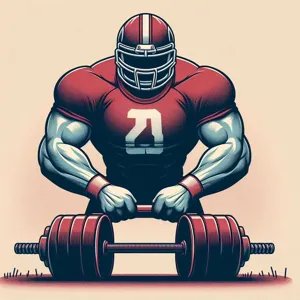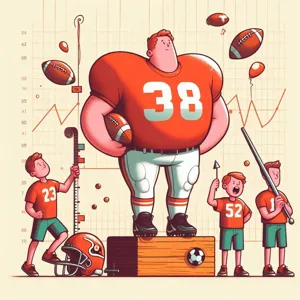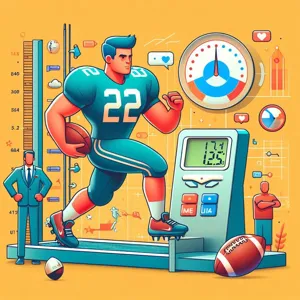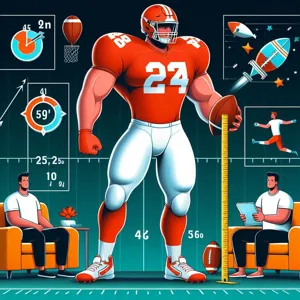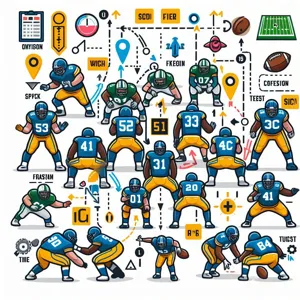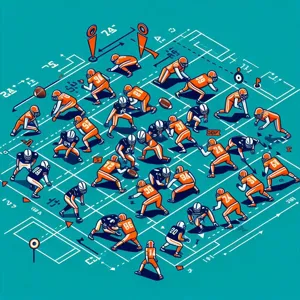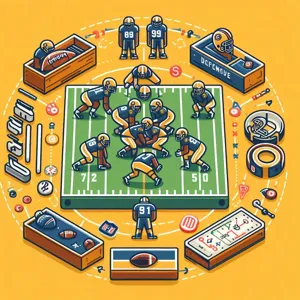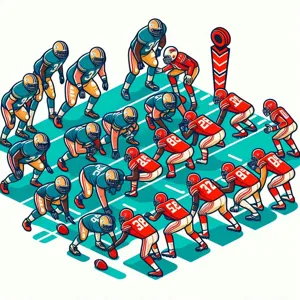In the fast-paced and high-stakes world of American football, the battle between offense and defense is a captivating dance of strategy and skill.
While offensive schemes often steal the spotlight with their dazzling plays and high-scoring potential, it is the defensive strategies that serve as the backbone of a team’s resilience and success. Understanding how to effectively counter offensive tactics is crucial for any aspiring coach or player looking to elevate their game. In this blog post, we will unpack the intricacies of defensive strategies, exploring various formations, player roles, and situational adjustments designed to thwart even the most ingenious offensive schemes. Whether it’s stifling a potent passing attack or shutting down a relentless rushing offense, mastering these defensive techniques will not only enhance your team’s performance on the field but also deepen your appreciation for the strategic complexity that defines American football. Join us as we dive into the art of defense and discover how to turn the tide in your favor!
1. Introduction to Defensive Strategies in Football
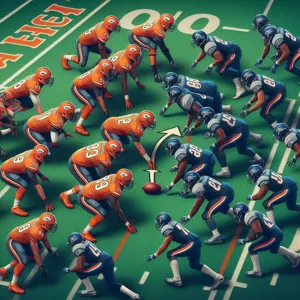
In the high-octane world of American football, the spotlight often shines on the offense—the dazzling plays, the star quarterbacks, and the thrilling touchdowns. However, lurking in the shadows, ready to pounce on any misstep, is the defense, a formidable force that can change the course of a game in an instant. Understanding defensive strategies is crucial for any player, coach, or fan looking to truly appreciate the intricacies of the sport.
Defensive strategies in football are not merely reactive; they are meticulously designed schemes that aim to thwart offensive plays, disrupt the rhythm of opposing teams, and ultimately secure victory. From the classic 4-3 and 3-4 formations to more modern concepts like the Tampa 2 or the Mike linebacker blitz, defenses are constantly evolving to adapt to the ever-changing landscape of offensive tactics.
At their core, these strategies revolve around key principles: anticipation, positioning, and teamwork. A successful defense requires players to read the offense’s formation and tendencies, anticipate their moves, and execute assignments with precision. Each player on the field has a specific role—whether it’s the defensive lineman’s job to penetrate the line of scrimmage, the linebacker’s duty to cover gaps, or the cornerback’s task of shadowing wide receivers. The interplay between individual responsibilities and collective execution can create a wall that even the most potent offenses struggle to breach.
In this blog post, we will delve deeper into various defensive strategies, exploring their strengths, weaknesses, and the nuances that make them effective against specific offensive schemes. By unpacking these defensive tactics, we can gain a greater appreciation for the chess match that unfolds on the gridiron, where every snap is a battle of wits, skill, and strategy. Whether you’re a die-hard fan, a budding coach, or an aspiring player, understanding the art of defense will enhance your knowledge of the game and its captivating dynamics.
2. Understanding Offensive Schemes: An Overview
To effectively counter offensive schemes in American football, it’s crucial to first grasp the diverse strategies and formations that offenses employ on the field. Offensive schemes are meticulously crafted to exploit defensive weaknesses and create mismatches, and understanding these intricacies is key for any defensive coordinator or player.
At the core of offensive strategy lies the playbook, a collection of plays that dictate how the offense will execute its game plan. These plays can range from power runs and quick slants to complex passing routes and misdirection tactics. One common offensive scheme is the West Coast offense, characterized by short, quick passes that are designed to control the clock and methodically move down the field. This scheme relies heavily on precise timing and the ability of the quarterback to read defenses effectively.
Another prevalent scheme is the spread offense, which aims to create space by spreading out the defense across the field. By utilizing multiple wide receivers and tight ends, the spread offense seeks to create favorable matchups, allowing for big plays both in the air and on the ground. This scheme often incorporates a mobile quarterback who can either escape pressure or execute read-option plays, further complicating defensive assignments.
Moreover, understanding the importance of formations is vital. The “I-formation,” “single back,” and “pistol formation” each provide unique advantages and dictate how defenses align themselves. Each formation can signal different types of plays, from running backs barreling through the line to dynamic passing plays that stretch the field vertically.
As defenses prepare to counter these offensive strategies, they must analyze trends, player tendencies, and situational strategies. This involves not only studying film but also being adaptable during the game, as offenses may adjust their schemes based on the defensive alignment they face. A thorough understanding of offensive schemes empowers defenses to anticipate plays, make critical adjustments, and ultimately regain control over the game. By dissecting these intricacies, defenses can craft focused strategies that neutralize an offense’s strengths and exploit its weaknesses.
3. The Role of the Defensive Coordinator
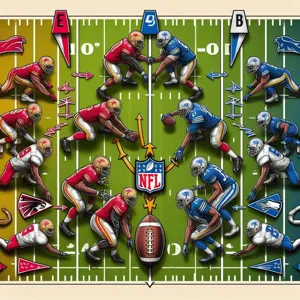
In the intricate chess match that is American football, the role of the defensive coordinator is pivotal. This individual serves as the strategic mastermind behind the defense, orchestrating the team’s response to the offensive schemes that unfold on the field. A defensive coordinator is not just a tactician; they are a visionary, analyzing opponents’ tendencies, strengths, and weaknesses, and crafting game plans that can effectively counteract the offensive strategies they will face each week.
One of the primary responsibilities of the defensive coordinator is to devise a game plan that aligns with the defensive philosophy of the team, whether it leans toward a more aggressive, blitz-heavy approach or a conservative, zone-based strategy. This involves a meticulous breakdown of film from previous games to identify patterns in the opponent’s play-calling and player behaviors. The coordinator must be adept at predicting what the offense will attempt, anticipating their moves, and preparing the defense to respond with precision.
During practices, the defensive coordinator is tasked with communicating these strategies to players, ensuring that each member of the defense understands their specific roles and responsibilities. This communication is crucial, as the effectiveness of a defensive scheme often hinges on the seamless execution of assignments under pressure. The coordinator also serves as a motivator, instilling confidence and discipline in the players, and fostering a sense of unity and purpose.
On game day, the defensive coordinator’s role evolves into that of an in-game strategist. As the game unfolds, they must be agile, adapting the defensive game plan based on the opposing offense’s performance and any adjustments they make. This requires not only a deep understanding of the game but also a keen sense of timing and the ability to make quick decisions. The defensive coordinator may call for shifts in coverage, substitutions, or adjustments in player alignments based on the flow of the game.
Ultimately, the success of a defensive unit often reflects the effectiveness of its coordinator. A well-prepared and adaptable defense can stifle even the most potent offenses, turning the tide of the game and securing victories. As fans watch the action unfold, they might not always see the invisible hand of the defensive coordinator at work, but their influence is undeniably felt on the field, making them a key figure in the strategic battle of American football.
4. Key Principles of Defensive Football
In the intricate dance of American football, defensive teams play a pivotal role in determining the outcome of a game. Understanding the key principles of defensive football can empower teams to thwart even the most aggressive offensive schemes. Here are the foundational elements that every effective defense should embody:
1. **Alignment and Assignment**: The first principle revolves around precise alignment and clear assignments. Each defender must know their position on the field and their specific responsibility in any given play. This clarity is crucial, as it ensures that players are in the right spots to counter offensive strategies effectively. Misalignment can lead to costly breakdowns, allowing offensive players to exploit gaps and create big plays.
2. **Reading the Offense**: Successful defenses thrive on their ability to read the offense. This involves studying the formation, recognizing pre-snap motions, and anticipating the quarterback’s intentions. Defensive players must be adept at deciphering cues that signal what the offense is likely to do. This anticipation allows defenders to react quicker, making them more effective in their pursuit of the ball.
3. **Tackling Fundamentals**: A fundamental aspect of defensive football is tackling technique. Proper tackling not only prevents yards after contact but also minimizes the risk of injury. Defenders must focus on maintaining a low center of gravity, wrapping up the ball carrier, and driving through the tackle. Mastery of these techniques not only enhances individual performances but also bolsters the overall effectiveness of the defensive unit.
4. **Communication and Cohesion**: In the chaotic environment of a football game, effective communication is paramount. Defensive players must constantly communicate their observations and intentions to one another, ensuring that everyone is on the same page. This cohesion allows a defense to function as a synchronized unit, adapting to the offense’s movements in real time. Whether it’s a simple shout of “pass” or a complex signal, effective communication can be the difference between a successful stop and a breakdown in coverage.
5. **Adjusting to Offenses**: A successful defense is not static; it evolves and adapts to the offensive schemes it faces. Defensive coordinators must be astute strategists, capable of making real-time adjustments to counteract the strengths of the opposing team. This adaptability includes shifting personnel, changing formations, and even altering the game plan mid-game. A defense that can adjust effectively is often one step ahead of the offense, thwarting their game plan before it even begins.
By incorporating these key principles into their gameplay, defensive teams can create a formidable barrier against offensive schemes, turning the tide of a game and keeping their opponents on the back foot. Understanding these tenets is essential for any player or coach aiming to build a strong defensive foundation.
5. Analyzing Common Offensive Schemes
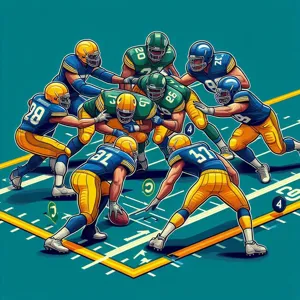
In the dynamic landscape of American football, understanding the offensive schemes employed by opponents is crucial for developing effective defensive strategies. Offensive schemes are meticulously designed to exploit defensive weaknesses, create mismatches, and ultimately score points. By analyzing these common schemes, defensive coordinators can craft tailored responses that neutralize the offense’s strengths and capitalize on their vulnerabilities.
One of the most prevalent offensive strategies is the **West Coast Offense**, characterized by short, quick passes designed to control the tempo and space of the game. Its emphasis on timing and precision requires a defense that can maintain tight coverage and anticipate the quarterback’s decisions. Defenders must be agile and coordinated, often employing zone coverage techniques to counteract the quick-release philosophy of this scheme.
Conversely, the **Spread Offense** seeks to create space by spreading the defense thin, capitalizing on mismatches in one-on-one situations. This scheme often utilizes four or five wide receivers, forcing defenses to either commit to player coverage or risk being caught in a zone that allows for easy completions. A solid counter to the Spread Offense involves employing a nickel or dime defense, adding extra defensive backs to counteract the aerial assault while maintaining the ability to rush the passer.
The **Power Run Game** is another common strategy that relies on aggressive, downhill running. It seeks to overpower the defensive front with larger offensive linemen and fullbacks leading the charge. To counter this, a defense may adopt a 4-3 alignment that enhances their ability to plug running lanes, or they might utilize a 3-4 formation to create confusion at the line of scrimmage. Linebackers must be disciplined and prepared to shed blocks, filling gaps quickly to halt advancing ball carriers.
Lastly, the **Read-Option** offense has surged in popularity, primarily in college and the NFL, exploiting the defense’s decision-making process. The quarterback reads the defensive end’s movement before deciding whether to hand off the ball or keep it himself. Defenders must be disciplined and aware of their responsibilities, often relying on a spy—usually a linebacker—to shadow the quarterback and ensure he does not break free for significant yardage.
By thoroughly analyzing these common offensive schemes, defensive teams can better prepare themselves to implement strategies that effectively neutralize their opponents’ strengths. This proactive approach not only enhances the defense’s performance but also fosters a deeper understanding of the game, allowing players to anticipate and react to the ever-evolving tactics on the field.
– 5.1. West Coast Offense
### 5.1. West Coast Offense
The West Coast Offense (WCO) revolutionized American football by prioritizing short, quick passes over traditional rushing plays, thereby emphasizing precision, timing, and versatility. Developed by legendary coach Bill Walsh in the 1970s, this offensive strategy is designed to create mismatches and exploit defensive weaknesses through a methodical and rhythmic approach to moving the ball down the field.
At its core, the WCO utilizes a series of horizontal and vertical routes that stretch the field, allowing quarterbacks to release the ball quickly and efficiently. This not only keeps the defense on their toes but also minimizes the risk of turnovers by reducing the time the ball is in the quarterback’s hands. By encouraging the use of running backs and tight ends as integral components of the passing game, the West Coast Offense also blurs the lines between run and pass plays, making it difficult for defenses to predict the offense’s next move.
Defensively, countering the West Coast Offense requires a nuanced understanding of both the routes run by the receivers and the timing of the quarterback’s release. Teams often employ zone defenses that emphasize quick reactions and disciplined coverage. By anticipating the quick, short throws characteristic of the WCO, defensive backs can position themselves to disrupt passes, while linebackers may need to drop into coverage to ensure that running backs and tight ends are effectively contained.
Moreover, effective pass rush is crucial; defensive linemen must apply pressure without allowing the quarterback the time to set his feet and make accurate throws. Blitzing can serve as a double-edged sword in this context, as it can create opportunities for big plays if the offense can successfully exploit the resulting gaps.
Ultimately, to successfully counter the West Coast Offense, teams must balance aggression with discipline, ensuring that they are well-prepared to react to the dynamic nature of this innovative offensive scheme. Understanding its principles allows defenses to make real-time adjustments, maximizing their chances of thwarting the quick-strike capabilities of their opponents.
– 5.2. Spread Offense
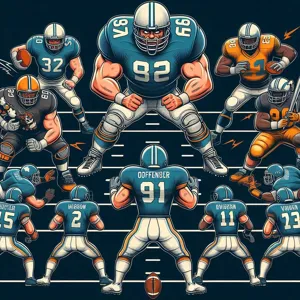
### 5.2. Spread Offense
The spread offense has revolutionized the way teams approach the game of American football, emphasizing speed, space, and alignment to create mismatches against defenses. Originating as a way to utilize the strengths of mobile quarterbacks and fast receivers, this offensive scheme spreads the field horizontally, often employing four or five wide receivers to stretch the defense. By doing so, it aims to create one-on-one matchups, allowing skilled playmakers to exploit their defenders in open space.
In a typical spread formation, the quarterback lines up in the shotgun position, allowing for quick decision-making and rapid ball distribution. This alignment not only facilitates a dynamic passing game but also opens up running lanes for elusive running backs. The defense, often forced to cover a larger area, finds itself at a strategic disadvantage, particularly if misaligned or unable to adapt quickly enough to the tempo of the offense.
Defensive strategies against the spread offense must be multi-faceted and highly adaptable. One effective approach is to employ a nickel or dime package, adding extra defensive backs to counter the plethora of receivers. This adjustment allows for better coverage against quick passes while also providing the flexibility to support against the run. Additionally, defenses may consider using zone coverage concepts to ensure that routes are effectively mirrored and that space is minimized, which can disrupt the rhythm of the spread offense.
Another critical aspect of countering a spread offense is the importance of a strong pass rush. By applying consistent pressure on the quarterback, defenses can force hurried throws and disrupt timing routes. Blitzing from various angles can catch the offensive line off guard, leading to potential sacks or hurried passes that could be intercepted. However, this strategy must be executed with caution; overly aggressive blitzing can leave gaps in coverage, providing the offense with opportunities to exploit mismatches downfield.
In summary, while the spread offense poses unique challenges with its emphasis on speed and space, a well-prepared defense can counter its effectiveness with strategic adjustments, disciplined coverage, and relentless pressure. Understanding the nuances of this dynamic offensive scheme is essential for any defensive unit aiming to regain control of the game and neutralize the threats posed by a high-octane offense.
– 5.3. Power Run Game
The power run game is a cornerstone of offensive strategy in American football, and defenses must be prepared to counter its effectiveness. This approach leverages the brute strength of offensive linemen and the relentless determination of running backs, aiming to establish dominance at the line of scrimmage. The hallmark of a power run game is its emphasis on straightforward, downhill running, often utilizing heavy formations to create mismatches against defenses.
Defending against this strategy requires a multifaceted approach. First and foremost, defenses need to focus on gap integrity. Each defender must understand their assignment and remain disciplined, ensuring that they occupy their designated gaps to thwart the running lanes that the offense seeks to exploit. This often means employing a four-man front, where linemen can engage blockers directly, while linebackers read the play and flow to the ball.
Another crucial aspect of countering the power run game is the use of alignment and leverage. Defensive coordinators may opt for a “plugging” technique, where defensive linemen engage offensive linemen head-on, using their strength to disrupt the offensive flow. Additionally, bringing downfield support through safety blitzes or linebacker stunts can help to fill gaps and surprise the offense, delivering a powerful message that their ground game will be met with resistance.
Moreover, conditioning plays a pivotal role in defending against a power run game, as it often results in a physical battle that tests the endurance of defensive players. coaches must ensure that their athletes are not only technically sound but also fit enough to withstand the rigors of repeated collisions. As the game progresses, fatigue can lead to missed tackles and blown assignments, allowing powerful running backs to capitalize on any weakness.
In summary, successfully countering the power run game requires a blend of disciplined gap control, strategic alignments, and physical conditioning. By understanding the offensive intent and preparing accordingly, defenses can disrupt the rhythm of the run game, forcing offenses to rethink their approach and adjust their game plans. This battle at the line of scrimmage is a classic clash of wills, and mastering it can be the difference between victory and defeat on the gridiron.
6. Defensive Formations: An Overview
Defensive formations are the backbone of any effective defensive strategy in American football, serving as the first line of counteraction against offensive schemes. They dictate how players position themselves on the field, aligning with the defensive coordinator’s game plan to mitigate the strengths of the opposing offense. Understanding the various formations can dramatically enhance a defense’s ability to anticipate plays and respond accordingly.
One of the most common formations is the **4-3 defense**, which features four defensive linemen and three linebackers. This setup provides a balanced approach, allowing for both strong run defense and flexibility in pass coverage. With the linemen focused on disrupting the offensive line and the linebackers ready to react to plays, the 4-3 formation is effective against a variety of offensive strategies.
In contrast, the **3-4 defense** employs three linemen and four linebackers, prioritizing speed and versatility. This formation can confuse offenses, as the extra linebacker can rush the passer or drop back into coverage, creating uncertainty for the quarterback. This adaptability makes the 3-4 a popular choice for teams that value dynamic defensive play.
Another noteworthy formation is the **Nickel defense**, which adds a fifth defensive back, typically in response to an offense that uses multiple wide receivers. This setup enhances pass coverage while still allowing the defense to maintain some level of run support. Similarly, the **Dime defense** takes it a step further, incorporating six defensive backs to counter high-flying passing attacks in obvious passing situations.
Each of these formations allows defensive teams to tailor their strategy to the specific strengths and weaknesses of their opponents. Whether it’s stacking the box to stop the run or spreading the field to defend against deep passes, understanding the nuances of defensive formations is essential for any team looking to counter offensive schemes effectively. By mastering these formations, defenses can create pressure, force mistakes, and ultimately swing the momentum of the game back in their favor.
– 6.1. 4-3 Defense
The 4-3 defense is one of the most popular and versatile formations in American football, offering a solid foundation for teams looking to counter a variety of offensive schemes. In this setup, the defense consists of four down linemen and three linebackers, providing a balanced approach that can adapt to both run and pass plays.
The strength of the 4-3 defense lies in its ability to control the line of scrimmage. The four defensive linemen create a formidable front, capable of pressuring the quarterback while also clogging running lanes. This alignment allows for a strong push against the offensive line, making it difficult for running backs to find holes and for quarterbacks to establish a rhythm in the pocket.
At the heart of the 4-3 defense are the three linebackers, who play a critical role in reading the offense and reacting accordingly. Their positioning allows them to defend against both the run and the pass, with the ability to drop back into coverage or step up to make tackles. The outside linebackers often serve as edge rushers, applying pressure on the quarterback or containing runs to the outside, while the middle linebacker typically acts as the defensive leader, calling plays and adjustments based on the offensive formation.
One of the key advantages of the 4-3 defense is its flexibility. Coaches can easily adjust player responsibilities based on the offensive formation they are facing. For instance, if the offense lines up with multiple tight ends, the defense can shift its focus to stopping the run, while against a spread offense, the linebackers can be tasked with dropping back into coverage to defend against quick passes.
However, the 4-3 defense is not without its challenges. It requires disciplined players who can execute their assignments effectively. A breakdown in communication or execution can leave gaps that a savvy offense can exploit. Additionally, if a team lacks the personnel to effectively rush the passer or cover receivers, the 4-3 can be less effective, especially against high-powered offenses that utilize quick throws and misdirection.
In summary, the 4-3 defense remains a cornerstone of defensive strategy in American football, offering a balanced approach that can adapt to various offensive schemes. Its ability to pressure the quarterback while providing solid run support makes it a formidable choice for teams looking to establish defensive dominance on the field. As coaches and players continue to fine-tune their understanding of this formation, the 4-3 defense will undoubtedly remain a key component in the ongoing chess match between offense and defense in the game of football.
– 6.2. 3-4 Defense
### 6.2. 3-4 Defense
The 3-4 defense is a dynamic strategy that has gained traction in the NFL and college football alike, standing as a testament to the evolving nature of defensive schemes. Named for its alignment, the 3-4 defense features three down linemen and four linebackers, creating a versatile setup that can adapt to various offensive plays and formations.
At its core, the 3-4 defense emphasizes speed and agility over sheer size, allowing teams to effectively counter both the run and pass. The three linemen are typically larger, more robust players who occupy the offensive line, holding their ground and freeing up the linebackers to make plays. The four linebackers, often a combination of inside and outside players, are crucial to the 3-4’s success. They possess the speed to pursue ball carriers, the intelligence to read plays, and the versatility to drop back into coverage when necessary.
One of the strengths of the 3-4 defense lies in its ability to disguise coverages and blitz packages. With four linebackers on the field, defensive coordinators can create confusion for the opposing quarterback by masking who will rush the passer and who will drop into coverage. This unpredictability can lead to hurried throws, sacks, and turnovers, making it a formidable scheme against aggressive offenses.
However, the 3-4 defense also comes with its challenges. It requires linebackers who can tackle effectively and cover ground quickly, as well as linemen who can control blocks and engage with offensive linemen without getting pushed around. Additionally, teams must ensure their defensive players are well-coached and versatile, as the success of a 3-4 defense hinges on the ability to adapt to different offensive strategies.
In summary, the 3-4 defense is a strategic approach that maximizes speed and flexibility, allowing teams to counter a variety of offensive schemes effectively. By focusing on player versatility and disguising intentions, teams can create a defensive powerhouse that keeps opponents guessing and struggling to find their rhythm.
– 6.3. Nickel and Dime Packages
In the intricate dance of American football, the defensive strategies employed are as varied and nuanced as the offensive schemes they aim to counter. Among these strategies, nickel and dime packages have emerged as essential tools in the modern defensive playbook, particularly in response to the increasing prevalence of pass-heavy offenses.
A nickel package typically involves the defense substituting a linebacker for an additional defensive back, resulting in five defensive backs on the field. This formation is designed to counteract the spread of offensive skill players across the field, providing the defense with enhanced coverage capabilities against multiple receiving threats. The added agility and speed of the nickel backs allow defenses to better match up against shifty wide receivers and tight ends, creating a formidable wall against aerial attacks.
On the other hand, the dime package elevates this concept even further, introducing a sixth defensive back and often sacrificing another linebacker or defensive lineman. This package is particularly effective in obvious passing situations, such as third-and-long scenarios, where the offense is likely to attempt a deep throw. By flooding the secondary with additional defensive backs, teams can create a complex web of coverage schemes that confuse quarterbacks and disrupt timing routes.
Both packages employ a variety of techniques to maintain a balance between pass coverage and run defense. Defensive coordinators often rely on disguising their intentions, using pre-snap movements to make it challenging for the offense to read their coverage. This strategy can force quarterbacks into hurried decisions, potentially leading to turnovers or stalled drives.
Moreover, the effectiveness of nickel and dime packages lies in their adaptability. Defenses can tweak their formations and personnel based on the offensive setup, making them versatile responses to the evolving landscape of the game. As offenses continue to innovate, utilizing multiple tight ends or an array of skilled receivers, the importance of these packages in a defensive strategy cannot be overstated. They provide a safety net, allowing defenses to cover a wide range of threats while maintaining the agility to respond to unexpected plays.
In summary, nickel and dime packages represent a crucial facet of defensive strategies in American football, enabling teams to stay one step ahead of inventive offenses. By prioritizing flexibility and coverage, these packages ensure that defenses can effectively neutralize passing threats while still being prepared for any surprises the offense might throw their way.
7. Key Defensive Techniques and Fundamentals
In the fast-paced world of American football, where offensive teams continuously seek to exploit weaknesses, mastering key defensive techniques and fundamentals is paramount for success. Understanding these foundational elements not only equips defenders to counter offensive plays effectively but also fosters a cohesive unit that can adapt to various game situations.
**Tackling Fundamentals:** At the heart of any solid defense lies the ability to tackle effectively. Proper tackling technique is crucial—not just for preventing yardage gains, but for ensuring player safety. Defenders are taught to approach the ball carrier with the right body position, using their shoulders to initiate contact while wrapping their arms around the opponent’s legs. This technique minimizes the risk of injury and maximizes the likelihood of a successful stop.
**Footwork and Agility:** A defender’s footwork can make or break a play. Quick, agile footwork allows defenders to maintain balance and change direction swiftly in response to offensive movements. Drills that focus on lateral movement, such as cone drills and ladder exercises, can enhance a defender’s agility and help them stay one step ahead of the offense. This agility is especially important for defensive backs who need to mirror receivers’ routes effectively.
**Reading the Offense:** Developing the ability to read the offense is a critical skill for any defender. This involves analyzing the offensive formation, recognizing pre-snap movements, and anticipating plays before they unfold. Defensive players should study film to familiarize themselves with opponents’ tendencies and signals. This preparation allows defenders to react quickly, often determining the outcome of a play.
**Communication and Teamwork:** Defense is not just about individual prowess; it’s about the synergy of a well-coordinated unit. Effective communication among players is essential for executing defensive schemes, whether in zone coverage or man-to-man assignments. Establishing clear signals and verbal cues enables defenders to adjust to offensive shifts and ensures that everyone is on the same page, minimizing errors and maximizing effectiveness.
**Pressuring the Quarterback:** A successful defense often hinges on the ability to apply pressure on the quarterback. Techniques such as blitzing and using various defensive alignments can disrupt the offense’s timing and rhythm. Linebackers and linemen must master the art of evading blockers and using speed and strength to reach the quarterback quickly. The pressure not only increases the chances of a sack but can force hurried throws, leading to mistakes and turnovers.
By focusing on these key defensive techniques and fundamentals, teams can establish a robust defensive strategy that not only counters offensive schemes but also instills confidence among players. As the season progresses, refining these skills will transform a good defense into a formidable force on the field, ready to take on any offensive challenge that comes their way.
8. Countering the Spread Offense: Strategies and Adjustments
Countering the Spread Offense: Strategies and Adjustments
The spread offense has revolutionized the way football is played, creating a fast-paced and highly dynamic environment that can leave even the most seasoned defenses scrambling. This offensive scheme aims to spread the field, allowing for quick passes and running lanes, while forcing defenses to cover more ground and make split-second decisions. To effectively counter this approach, defensive coordinators must implement a blend of strategies and tactical adjustments that can neutralize the spread’s advantages and regain control of the game.
One foundational strategy is to adopt a hybrid defensive formation, often referred to as the “Nickel” or “Dime” package. By adding extra defensive backs, teams can enhance their pass coverage without sacrificing speed. This adjustment allows defenders to match up against the offensive skill players—wide receivers and tight ends—who thrive in the open field. Additionally, utilizing versatile linebackers who can drop into coverage or rush the passer provides the defense with the flexibility needed to respond to the offense’s shifting formations and quick tempo.
Another crucial adjustment is to prioritize communication and alignment. Pre-snap reads become vital as defenses must quickly identify offensive formations and personnel groupings. Employing a “check with me” system can empower players to make quick adjustments based on the offensive alignment, ensuring that everyone is in the correct position to defend against potential plays. This heightened awareness can disrupt the rhythm of the spread offense, forcing them to hesitate or make mistakes.
Moreover, press coverage can be an effective tool against spread formations. By jamming receivers at the line of scrimmage, defenders can disrupt timing routes and limit the quarterback’s options. This tactic requires strong, physical cornerbacks who can hold their ground against quick receivers, but when executed correctly, it can throw the entire offensive scheme off balance.
Finally, a relentless pass rush cannot be understated. Defensive linemen must engage in stunts and blitzes to apply pressure on the quarterback and disrupt the timing of the play. Incorporating a mix of interior and exterior pressure can make it challenging for the offense to establish a rhythm, forcing hurried decisions and mistakes.
In conclusion, countering the spread offense demands a multifaceted approach that combines strategic formation adjustments, effective communication, physical coverage, and a relentless pass rush. By implementing these strategies, defenses can not only neutralize the spread’s effectiveness but also seize control of the game, turning the tables on an offense that thrives on making quick, decisive plays.
9. Stopping the Run: Defensive Line and Linebacker Roles
Stopping the run is one of the fundamental responsibilities of a football defense, requiring a coordinated effort between the defensive line and linebackers. In this section, we’ll unpack the critical roles these two units play in shutting down the opposition’s ground game.
The defensive line acts as the first line of defense, tasked with occupying blockers and creating chaos at the line of scrimmage. Each player on this front must effectively engage with offensive linemen, using leverage and strength to disrupt running lanes. A well-coordinated defensive line will not only clog gaps but also penetrate the backfield, putting pressure on the running back before they can gain momentum. Techniques such as gap control and stunting are essential here; players must know their responsibilities and communicate effectively to ensure they maintain their assignments while responding to the offensive formation.
Meanwhile, the linebackers serve as the second layer of defense, responsible for reading the play and reacting quickly. Their role is multifaceted: they must diagnose the run play as it unfolds, navigate through blocks, and fill gaps left by the defensive line to make tackles. Linebackers are often considered the “quarterbacks” of the defense, as their ability to recognize offensive schemes and make split-second decisions can be the difference between a short gain and a big play. They need to possess a keen football IQ, allowing them to anticipate the runner’s path and adjust their positioning accordingly.
Effective run defense requires seamless teamwork between these two units. The defensive line must occupy blockers effectively to allow linebackers the freedom to move and make plays, while linebackers must trust their linemen to hold their ground and control gaps. When both units work in harmony, they create a formidable barrier against the run, forcing the offense to reconsider their strategy and potentially abandon the ground game altogether. In essence, the strength of stopping the run lies in the synergy between the defensive line and linebackers, a critical component in any successful defensive scheme.
10. Secondary Strategies: Coverage Schemes Explained
In the intricate realm of American football, the secondary is often the last line of defense, tasked with the critical responsibility of thwarting passing attacks. Effective coverage schemes are essential for a defense to counter the diverse offensive strategies employed by opponents. Understanding these coverage schemes can significantly enhance a team’s defensive prowess, allowing them to adapt and respond to various offensive formations and plays.
Coverage schemes can be broadly classified into man-to-man and zone coverage, each with its distinct strategies and applications. **Man-to-man coverage** involves assigning each defensive back or linebacker to a specific offensive player, creating a shadowing effect that aims to deny them the opportunity to catch the ball. This strategy demands exceptional athleticism and awareness from the defenders, as they must closely track their assigned receivers, anticipating their routes and motion.
On the other hand, **zone coverage** allows defensive players to cover specific areas of the field rather than individual players. This approach requires defenders to read the quarterback’s intentions and react accordingly, often relying on their instincts and communication with teammates. Zone coverage can be particularly effective against complex offensive schemes, as it provides a safety net against route combinations designed to exploit man coverage.
Within these broad categories, there are numerous variations and hybrid schemes that blend elements of both man and zone coverage. For instance, the **Cover 2 scheme** splits the field into two deep zones, with cornerbacks guarding the flat areas, while the **Cover 3** utilizes three defenders deep, providing additional protection against the long ball. Teams may also employ **press coverage**, where defenders engage receivers at the line of scrimmage, disrupting their timing and rhythm.
Ultimately, the effectiveness of these coverage schemes hinges on the players’ understanding of their roles, communication, and the ability to adapt on the fly. Coaches must consistently analyze opponents’ tendencies, adjusting their coverage strategies to counter offensive threats effectively. As the game evolves, so too must the defensive strategies, ensuring that the secondary remains a formidable force capable of neutralizing any passing attack thrown their way. By mastering these coverage schemes, teams can bolster their defensive integrity and keep the opposition’s offense in check.
– 10.1. Man-to-Man Coverage
### 10.1. Man-to-Man Coverage
Man-to-man coverage is a foundational defensive strategy in American football, revered for its intensity and individual accountability. In this scheme, each defensive player is assigned a specific offensive player to cover throughout the play, creating a one-on-one matchup that can significantly disrupt an opponent’s rhythm. The essence of man-to-man coverage lies in the defender’s ability to stay glued to their assigned target, using agility, speed, and anticipation to nullify the receiver’s routes.
One of the key advantages of this approach is its versatility; defenses can employ various alignments and techniques to adapt to the strengths and weaknesses of both their own players and the opposing offense. For instance, cornerbacks often take on wide receivers, utilizing their quickness and footwork to mirror the receiver’s movements. Meanwhile, linebackers may engage with running backs or tight ends, leveraging their physicality and coverage skills to maintain an edge in these critical matchups.
However, the effectiveness of man-to-man coverage hinges on the defensive players’ ability to maintain tight coverage while also being aware of the play’s progression. This can be particularly challenging when facing dynamic offenses that utilize motion and complex route combinations to create mismatches. In these scenarios, communication becomes crucial; defenders must alert each other to switches or picks, ensuring that no offensive player slips through the cracks unnoticed.
Despite its challenges, man-to-man coverage can be a potent weapon when executed properly. It can lead to turnovers, as defenders are often in a position to contest passes directly, and it can also force the quarterback to make quicker decisions under pressure. Coaches often employ this scheme in high-stakes situations, knowing that a well-timed man-to-man coverage can shift the momentum of the game in an instant. Understanding the nuances of this defensive strategy not only prepares defensive units for the challenges they will face on the field but also instills a sense of confidence that stems from knowing they are equipped to go toe-to-toe with any offensive scheme.
– 10.2. Zone Coverage
In the intricate dance of American football, where every play can pivot the momentum of the game, zone coverage emerges as a pivotal defensive strategy, offering a robust counter to offensive schemes that seek to exploit man-to-man coverage. At its core, zone coverage divides the field into specific areas, with defensive players assigned to cover designated zones rather than specific opponents. This tactical approach allows teams to adapt to the offensive formation and the quarterback’s movements, providing flexibility and a heightened awareness of the field.
Imagine a defense employing a classic Cover 2 scheme. In this configuration, two safeties patrol the deep zones, ensuring that any deep passes are contested, while the cornerbacks and linebackers cover the shorter zones, ready to jump routes and disrupt the quarterback’s timing. This alignment not only protects against big plays but also creates opportunities for interceptions, as defenders can read the quarterback’s eyes and anticipate throws into their zones.
What makes zone coverage particularly effective is its ability to confuse quarterbacks. When executed correctly, a defense can disguise its intentions, appearing to show one type of coverage before the snap and shifting to another post-snap. This unpredictability can lead to hurried decisions by the offensive signal-caller, resulting in errant throws or even costly turnovers.
Moreover, zone coverage fosters teamwork and communication among defenders. Each player must be aware of their responsibilities while also keeping an eye on their teammates’ zones, ensuring that they can seamlessly pass off receivers if they enter another player’s area of responsibility. This cohesion is vital, especially against offenses that rely on quick, rhythm-based passing attacks.
However, zone coverage is not without its challenges. Offenses can exploit soft spots within a zone, particularly if the defenders are too far off the line of scrimmage or if there are lapses in communication. Agile receivers can find seams in the coverage and exploit mismatches, leading to significant yardage gains.
Ultimately, mastering zone coverage requires a blend of strategy, athleticism, and teamwork. When executed flawlessly, it serves as an impenetrable fortress against offensive schemes, frustrating quarterbacks and receivers alike, and creating a pathway to defensive dominance on the field. It’s this intricate balance of discipline and adaptability that makes zone coverage a cornerstone of defensive strategies in American football.
11. The Importance of Communication on Defense
In the high-stakes world of American football, the importance of communication on defense cannot be overstated. Defensive players often find themselves in a whirlwind of action, where split-second decisions can make all the difference between a successful stop and a long touchdown run. In this chaotic environment, effective communication becomes the linchpin that holds the defensive unit together, allowing them to anticipate, adapt, and respond to the offense’s ever-changing strategies.
At its core, communication on defense is about more than just shouting play calls; it involves a complex interplay of verbal cues, non-verbal signals, and a shared understanding of each player’s responsibilities. As the offense lines up, defenders must quickly identify formations and potential threats. Cornerbacks might call out adjustments based on the wide receiver’s stance, while linebackers may need to relay information about the offensive line’s shifting positions. This constant dialogue fosters synergy, ensuring that each player is aware of their role and can react accordingly.
Moreover, communication extends beyond the field. Defensive players must engage in discussions during practice sessions, breaking down film together to identify tendencies and weaknesses in their opponents. This proactive approach not only prepares them for the game but also builds a camaraderie that enhances trust among teammates. When players feel comfortable communicating openly, they are more likely to make confident decisions during high-pressure situations.
A well-coordinated defense can disrupt an offense’s rhythm, forcing turnovers and minimizing big plays. Teams like the Seattle Seahawks during their “Legion of Boom” era exemplified this principle, where their defensive backfield was renowned for its seamless communication and ability to adjust on the fly. By prioritizing communication, defenses can not only elevate their performance but also instill a sense of unity and purpose that is essential for success on the field. In essence, effective communication is not just a tactical advantage; it is the foundation upon which championship defenses are built.
12. Adapting to In-Game Situations: Adjustments and Reactions
In the high-stakes world of American football, the ability to adapt to in-game situations can often be the difference between victory and defeat. As the game unfolds, coaches and players must remain vigilant, ready to analyze and respond to the offensive schemes deployed by their opponents. This dynamic environment requires a keen understanding of not just your own playbook, but also the nuances of the opposing team’s strategy.
After the opening drives, adjustments become crucial. If the offense is exploiting a weakness in the defensive line—perhaps through quick passes or outside runs—the defensive coordinator must swiftly implement countermeasures. This could mean shifting the defensive formation, bringing in additional linebackers to bolster run support, or employing a more aggressive blitz package to disrupt the quarterback’s rhythm. The ability to read the game’s flow and make these decisions in real-time is what separates good teams from great ones.
Communication is equally vital in these moments. Defensive players must be in sync, relaying adjustments and ensuring everyone is on the same page. A simple hand signal or a code word can convey a significant change in strategy, allowing the defense to adjust seamlessly. This level of coordination not only enhances defensive performance but also instills a sense of confidence among the players, knowing they can rely on one another to adapt under pressure.
Moreover, studying the opponent’s tendencies throughout the game can provide valuable insights. Is the offense favoring a particular formation? Are they consistently targeting a specific receiver? These patterns can inform defensive adjustments, allowing teams to anticipate plays rather than merely react to them. By identifying and exploiting these tendencies, defenses can create opportunities for turnovers and disrupt the offensive flow.
In summary, adapting to in-game situations through quick adjustments and effective communication is a cornerstone of successful defensive strategy in American football. Coaches and players alike must remain agile, ready to pivot as the game evolves, ensuring they can counter even the most sophisticated offensive schemes with confidence and precision. The hallmark of a formidable defense isn’t just its initial setup, but its relentless ability to adapt, react, and overcome in the heat of competition.
13. Analyzing Successful Defensive Plays: Case Studies
In the high-stakes world of American football, analyzing successful defensive plays can provide invaluable insights for teams looking to enhance their defensive schemes. By studying case studies of standout defensive performances, coaches and players can glean practical lessons that can be applied on the field.
Take, for instance, the 2015 Super Bowl matchup between the New England Patriots and the Seattle Seahawks. The Patriots’ defensive unit showcased a masterclass in situational awareness and adaptability. In the dying moments of the game, with the Seahawks poised to score the winning touchdown, the Patriots executed a perfectly timed goal-line stand. By employing a combination of zone coverage and aggressive pass rush, they forced Seahawks quarterback Russell Wilson into a hurried throw, resulting in the infamous interception by Malcolm Butler. This case illustrates the importance of preparation and reading the opposing offense’s tendencies, as the Patriots had anticipated the play call and positioned themselves accordingly.
Another compelling example comes from the 2020 NFL season, where the Miami Dolphins’ defense turned heads with their innovative use of blitz packages. In a game against the Los Angeles Rams, the Dolphins used an array of blitzes to confuse the Rams’ offensive line and disrupt quarterback Jared Goff’s rhythm. By strategically deploying players from unexpected positions, the Dolphins not only generated pressure but also created turnovers, leading to a decisive victory. This case underscores the effectiveness of unpredictability in defensive schemes, demonstrating how creative play calling can dismantle even the most formidable offenses.
Moreover, we can’t overlook the defensive prowess of the Chicago Bears in their 1985 Super Bowl season. Under the leadership of defensive coordinator Buddy Ryan, the Bears employed the “46 Defense,” a scheme that overwhelmed opponents with its aggressive front seven and opportunistic secondary. Their ability to stifle the run and apply relentless pressure on the quarterback became their trademark, leading to a dominant postseason run. This historic case study highlights the significance of a cohesive defensive unit that not only understands its roles but also thrives on synergy and communication.
By dissecting these successful defensive plays, teams can identify key strategies and principles that contribute to effective defense. Whether it’s mastering situational awareness, embracing creativity in play calling, or building a strong, cohesive unit, the lessons learned from these case studies serve as a blueprint for defensive success in American football. Ultimately, it’s this analytical approach—rooted in past successes—that empowers teams to elevate their defensive game and counter even the most sophisticated offensive schemes.
14. Training and Drills for Defensive Players
Training and drills for defensive players are crucial components in mastering the art of countering offensive schemes in American football. A well-prepared defense can significantly disrupt an opponent’s game plan, making the difference between a win and a loss. The foundation of effective defensive play lies in rigorous training that focuses on both individual skill development and cohesive team strategies.
First and foremost, conditioning and physical fitness are non-negotiable. Defensive players must possess the speed, strength, and agility to react quickly to unpredictable offensive movements. Incorporating high-intensity interval training (HIIT) can enhance stamina and explosiveness, allowing defenders to maintain peak performance through the duration of the game.
Next, focus on positional drills tailored to the specific roles within the defense. Linebackers, for instance, should engage in drills that emphasize tackling techniques, reading the quarterback’s eyes, and recognizing offensive formations. Meanwhile, defensive backs should participate in footwork and coverage drills designed to improve their ability to shadow receivers and anticipate routes. Incorporating reaction drills can further sharpen their instincts, helping them to read the offense and adjust their positioning in real-time.
Additionally, simulated game situations are invaluable for reinforcing teamwork and communication among defensive players. Conducting scrimmages that mimic offensive schemes allows defenders to practice their responses to various plays, fostering a deeper understanding of their responsibilities within the overall defensive strategy. This not only builds confidence but also enhances the synergy required for effective teamwork.
Film study is another essential aspect of training. Reviewing game footage allows defensive players to analyze their performance, study opponents’ tendencies, and identify areas for improvement. Coaches should encourage open discussions about strategies and adjustments, ensuring that players are not only passive observers but active participants in their learning process.
Finally, incorporating mental training techniques can greatly enhance a defender’s game-day performance. Visualization exercises, mindfulness practices, and situational awareness drills can help players maintain focus and composure under pressure, allowing them to execute their training when it matters most.
In summary, a comprehensive training regimen for defensive players goes beyond physical workouts; it encompasses skill development, tactical understanding, and mental fortitude. By investing time and effort into these areas, defenses can build a formidable presence on the field, ready to counter any offensive scheme with precision and confidence.
15. Conclusion: The Future of Defensive Strategies in Football
As the game of football evolves, so too do the strategies that define its very essence. The future of defensive strategies in American football promises to be an exciting landscape marked by innovation, adaptability, and a deeper understanding of the game’s nuances. With offenses continuing to grow more sophisticated—incorporating faster-paced play, intricate schemes, and versatile athletes—defensive coordinators will need to think outside the box to stay one step ahead.
One of the most significant trends we can anticipate is the integration of advanced analytics into defensive game plans. Just as teams now leverage data to dissect offensive tendencies, we will see a new wave of defensive strategies driven by real-time analytics that can predict opposing plays and formations. This shift will empower defensive players to make informed decisions at lightning speed, enhancing their ability to disrupt offensive rhythms.
Additionally, the increasing emphasis on hybrid players—athletes who possess the agility of a safety and the strength of a linebacker—will redefine defensive alignments. These versatile players will enable coaches to employ more dynamic schemes, blurring the lines between traditional roles and creating mismatches that confuse offenses and disrupt their game plans.
Moreover, with the growing influence of technology, we can expect to see enhanced training methods that focus on situational awareness and decision-making. Virtual reality and simulation tools may become commonplace, allowing defenders to practice against a multitude of offensive scenarios without the physical toll of traditional drills.
As fans, we must also consider the impact of rule changes and evolving safety protocols on defensive strategies. Protecting players while maintaining the integrity of the game will require a delicate balance, pushing defenses to adapt and innovate in response to new regulations.
Ultimately, the future of defensive strategies in football is poised to be a thrilling combination of tradition and transformation. As teams embrace change and leverage new technologies, we can look forward to witnessing a new era of defensive prowess that challenges our understanding of the game and keeps fans on the edge of their seats. The question remains: who will rise to the occasion and master the art of defense in this ever-changing arena? Only time will tell, but one thing is for certain: the evolution of defensive strategies will continue to shape the narrative of American football for years to come.
In conclusion, mastering defensive strategies in American football is essential for any team aspiring to outmaneuver their opponents. By understanding the nuances of offensive schemes and implementing the tactics we’ve discussed, coaches and players can create a formidable defense that not only disrupts plays but also anticipates the offensive team’s moves. From adjusting formations to leveraging player strengths, each strategy plays a crucial role in maintaining control on the field. As you prepare for your next game, remember that a well-executed defensive plan can turn the tide in your favor, showcasing the dynamic interplay of strategy and skill that makes football such an exhilarating sport. Embrace these insights, refine your approach, and watch your team’s performance soar as you counter even the most sophisticated offensive schemes!

